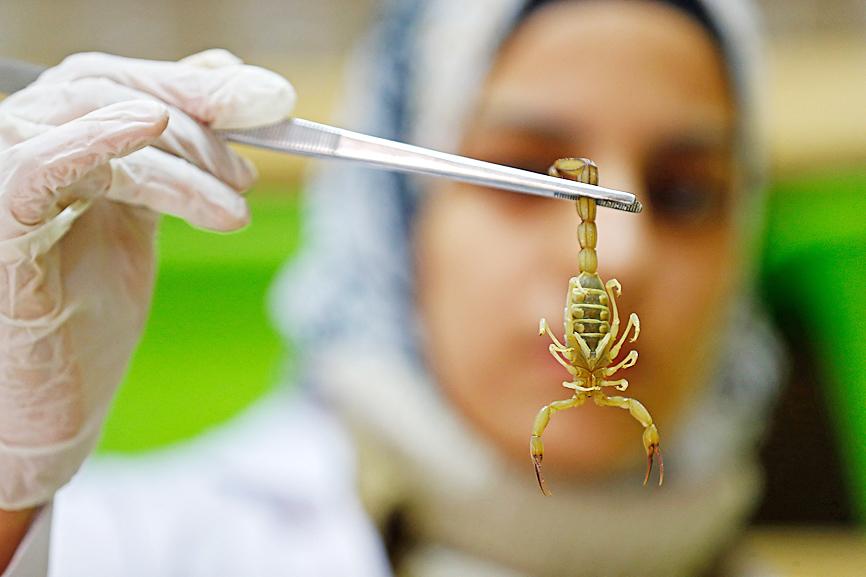Surrounded by thousands of live scorpions in a laboratory deep in Egypt’s Western Desert, Ahmed Abu al-Seoud carefully handles one of the curved-tailed arachnids before extracting a drop of its venom.
A mechanical engineer who worked in the oil sector for almost two decades, Abu al-Seoud decided in 2018 to strike a different path — producing scorpion venom for pharmaceutical research purposes.
“I was surfing the Internet and saw scorpion venom was one of the most expensive on the market,” said the 44-year-old, clad in a white lab coat.

Photo: AFP
“So I thought to myself: Why not take advantage of this desert environment where they roam around?” he added.
Biomedical researchers are studying the pharmaceutical properties of scorpion venom, making the rare and potent neurotoxin a highly sought-after commodity, produced in several Middle Eastern countries.
“Dozens of scorpion-derived bioactive molecules have been shown to possess promising pharmacological properties,” said a review published in May last year in the online journal Biomedicines.
It said that labs are studying its potential anti-microbial, immuno-suppressive and anti-cancer effects, among others, hoping to one day use or synthesize them for medicines.
Abu al-Seoud is from the Dakhla oasis, in Egypt’s vast New Valley province and about 800km southwest of the capital, Cairo.
Sand dunes and towering palms surround his laboratory, which he affectionately calls the “Scorpion Kingdom.”
“Here, every family has a story about a scorpion sting,” Abu al-Seoud said.
To get the animals to secrete venom in the controlled conditions of the lab, the scorpions are given a slight electric shock.
Workers wait 20 to 30 days between extractions to obtain the highest quality venom.
“What matters is the level of purity,” Abu al-Seoud said, adding that 1g requires the venom of 3,000 to 3,500 scorpions.
The liquid is refrigerated and transported to Cairo, where it is dried and packaged for sale as powder.
The government-certified laboratory has the ability to export “this unique product,” said 25-year-old Nahla Abdel-Hameed, a pharmacist who works at the center.
Abdel-Hameed referred to some scientific studies that explored the healing benefits of the venom in curing certain diseases.
Mohey Hafez, a member of the pharmaceutical chamber at the Federation of Egyptian Industries, was more cautious in his assessment of its current uses.
“Scorpion and snake venoms can be used in making antisera,” he said.
“There is no ready-made medication that entirely depends on the venom as a direct ingredient, but there has been promising research into its uses,” he added.
New Valley province boasts of about five different species of scorpions, including the sought-after deathstalker, whose venom sells for up to US$7,500 per gram, according to Abu al-Seoud.
While he himself also catches the creatures, he employs residents of nearby villages for the risky activity, equipping them with gloves, tweezers, boots, UV lights — and antivenom.
The scorpion hunters earn 1 to 1.5 Egyptian pounds (US$0.06 to US$0.10) per animal.
Abdel-Hameed said that the arachnids are caught in residential areas so as not to harm “the ecological balance.”
There are plans to breed the scorpions rather than catch them, colleague Iman Abdel-Malik said.

END OF AN ERA: The vote brings the curtain down on 20 years of socialist rule, which began in 2005 when Evo Morales, an indigenous coca farmer, was elected president A center-right senator and a right-wing former president are to advance to a run-off for Bolivia’s presidency after the first round of elections on Sunday, marking the end of two decades of leftist rule, preliminary official results showed. Bolivian Senator Rodrigo Paz was the surprise front-runner, with 32.15 percent of the vote cast in an election dominated by a deep economic crisis, results published by the electoral commission showed. He was followed by former Bolivian president Jorge “Tuto” Quiroga in second with 26.87 percent, according to results based on 92 percent of votes cast. Millionaire businessman Samuel Doria Medina, who had been tipped

ELECTION DISTRACTION? When attention shifted away from the fight against the militants to politics, losses and setbacks in the battlefield increased, an analyst said Recent clashes in Somalia’s semi-autonomous Jubaland region are alarming experts, exposing cracks in the country’s federal system and creating an opening for militant group al-Shabaab to gain ground. Following years of conflict, Somalia is a loose federation of five semi-autonomous member states — Puntland, Jubaland, Galmudug, Hirshabelle and South West — that maintain often fractious relations with the central government in the capital, Mogadishu. However, ahead of elections next year, Somalia has sought to assert control over its member states, which security analysts said has created gaps for al-Shabaab infiltration. Last week, two Somalian soldiers were killed in clashes between pro-government forces and

Ten cheetah cubs held in captivity since birth and destined for international wildlife trade markets have been rescued in Somaliland, a breakaway region of Somalia. They were all in stable condition despite all of them having been undernourished and limping due to being tied in captivity for months, said Laurie Marker, founder of the Cheetah Conservation Fund, which is caring for the cubs. One eight-month-old cub was unable to walk after been tied up for six months, while a five-month-old was “very malnourished [a bag of bones], with sores all over her body and full of botfly maggots which are under the

BRUSHED OFF: An ambassador to Australia previously said that Beijing does not see a reason to apologize for its naval exercises and military maneuvers in international areas China set off alarm bells in New Zealand when it dispatched powerful warships on unprecedented missions in the South Pacific without explanation, military documents showed. Beijing has spent years expanding its reach in the southern Pacific Ocean, courting island nations with new hospitals, freshly paved roads and generous offers of climate aid. However, these diplomatic efforts have increasingly been accompanied by more overt displays of military power. Three Chinese warships sailed the Tasman Sea between Australia and New Zealand in February, the first time such a task group had been sighted in those waters. “We have never seen vessels with this capability